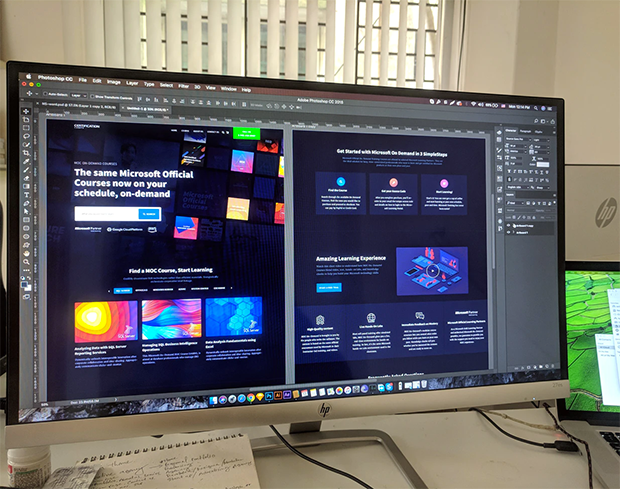These days everyone knows your website is one of the most crucial elements to any successful brand. But do you know what web developers really do? We’ve simplified the jargon, so that you’re ready to build your next kick ass website.
What is a Web Developer?
A Web Developer is responsible for writing code to produce functioning websites and applications that work across a variety of devices and browsers. The Web Developer will take a web design and establish the best way to recreate it using web programming languages. Different Web Developers will have different skill sets and will specialise in different areas, such as design, performance, accessibility and database management.
What does a Web Developer do?
1. Turns static designs into functioning websites
A developer’s main job is to take static designs, often made in software such as Adobe Photoshop, and turn it into a dynamic website that a user can click through. Web Developers have to work closely with Designers and User Experience (UX) professionals to ensure that their original designs and UX insight are translated correctly into code.

2. Content management system (CMS) integration
A content management system allows users to create, modify and manage the content on their website. Developers get paid to code, but you don’t. A CMS allows ordinary users to have control over the content on their website without having to rely on a developer to edit code. It is a developer’s responsibility to integrate the CMS into a website, they have to think about which areas of a website you will need to modify.
An example of this could be a news/article area of a website. As a business this area of your website is likely to change on a regular basis, you may want to add new articles, delete old ones or make changes to old content.
3. Database management
Websites that include login areas, e-commerce, or even a simple user comment section, will require a database to store data. Not only does a Web Developer need to ensure that data can be sent and received from a database, but it needs to be secure when doing so. Therefore, developers need to encrypt private data such as user passwords and home addresses.
This means that if a malicious user such as a hacker, was to access the database without permission they wouldn’t be able to access the user data. They would simply just see the encrypted data, which is just a long random string of letters numbers and special characters.
4. Testing
It’s one thing to have your website working on a desktop monitor, but what happens if a user wants to load your website on a phone, an iPad or even a digital watch? What will your website look like? Developers need to ensure that websites are responsive to the size of a users’ screen, allowing users to access websites on any device. The same goes for internet browsers. The way your website works in Google Chrome may be completely different to how it looks in Safari or Internet Explorer. This is called cross-browser testing and is an important part of a developer’s job. Part of this job is balancing user requirements and design with browser compatibility. Not all browsers support the same features, so a developer has to balance supporting the maximum amount of browsers against including a feature that may not be fully supported.

What is the difference between Front-end Development and Back-end Development?
Front-end Development
In short, a Front-end Developer is responsible for making sure the website looks great and reflects the original design. Design, layout, images, navigation and internal links are all elements of a website that will be controlled by the Front-end Developer. Any animation or transitions on web pages is also their responsibility. The Front-end Developer may also have to consider things like User experience and ensuring that their website works on a variety of different devices and browsers. It is important that the Front-end Developer builds websites which are optimised for mobile, with over 50% of websites being accessed on mobile.
Back-end Development
Back-end Developers are responsible for everything you don’t see, but that doesn’t mean it’s not important. Think of the back-end as a car engine, you don’t see it much, but without it your car isn’t going anywhere. The same goes for web development, you can have a beautiful form designed and built by a Front-end Developer, but if the form data isn’t going anywhere in the back-end then you aren’t going to be hearing from any customers that have filled that form out.
A really important part of back-end development is linking the site up to WordPress or another CMS such as Drupal or Magento. This allows clients to edit content on their site. Back-end Developers need to work closely with the client to understand which parts of the website they will need to be able to modify.
User experience design
To create great websites that work for users we need to consider user experience before anything else. User experience design is the process of enhancing product satisfaction by improving the usability, accessibility, and pleasure provided in interacting with a product. UX isn’t something that is just done at the end or start of a project, it is a key part of the web design process. At the start of a project the UX Designer is often responsible for creating a sitemap; this establishes all the different pages and information architecture of your website. Once a sitemap has been created the next stage is often wireframing. Wireframes are what’s known as low-fidelity prototyping, which means they focus on functionality rather than visual design. They can be created very quickly which allows for fast iteration. Wireframes save time in the web development process as they help establish what is needed on each page by using simple sketches and layouts. It is much quicker to do this in the wireframe stage as changes are quick and simple.

It’s important for the UX Designer to work closely with the client to establish their goals of the website. They can then optimise the website to deliver the different types of goal conversions such as check purchases, contact enquiries or video plays. When a project has been completed the UX Designer can look at if the goals have been achieved and provide UX solutions for improving the websites conversions. In smaller agencies UX Design is often the responsibility of the Front-end Developer. You can read more about UX in the Supremo UX Guides.
What’s the difference between a Web Designer and Web Developer?
The Web Designer is responsible for the layout design and general aesthetic of a website, whereas a Web Developer is responsible for translating this into code that produces a functioning website. Traditionally a web designer will use design tools such as Figma, Photoshop and InVision to create pixel perfect designs for the developer to recreate using code. However, these days the terms are often used interchangeably, with web designers often also being responsible for the development of websites.
What are page builders?
Page builders allow marketing teams and non-technical users to quickly create pages without the need for a development team or digital agency. The user will be able to select which modules they want to add to a page, and in which order they want to display them in. Page builders are great for teams that need to quickly put pages together in just a few minutes with no new development cost each time. Although there may be extra cost at the start of the project, a page builder could save you money in the long run, especially if you need to be able to run new promotions and introduce PPC pages into your website. It’s important that Web Developers work closely with clients during the development of any page builder to establish the different elements and modules that the client will need to add.
What are Website Builders and should I use one?
Website Builders are tools that allow you to quickly create websites without any code, often simply using drag and drop features. This means they require minimal technical knowledge and can be created by anyone with a basic knowledge of the web. They can be great for quickly building small websites with limited budgets, as they can be created without professional guidance by using pre-built elements and modules such as navigation bars and footers. Wix, Weebly and Squarespace are all examples of popular Website Builders.

However, Website Builders aren’t for everyone and may not be right for your business. Website Builders give you some freedom over the design and usability of your website without consulting any experts. This often means that these websites lack professionalism and a cutting edge when it comes to design. Many website builders answer this problem using website templates. These are pre-built websites that allow you to edit colours, images and text, this allows you to have a professional looking website in a minimal amount of time. However, these templates are a popular choice for many businesses, this leads to many websites looking very similar and these won’t allow your brand to stand out from your competitors. There are also performance and security considerations that you need to make when using a Website Builder. They often rely on different plugins to allow you to add ecommerce sections, forms and elements such as video. All these plugins can slow your website down and create a poor user experience. You can also never be certain that these plugins are 100% secure, which is crucial when they are handling your users’ data.
It’s also important to note that once you’ve built a website on a Website Builder you will have to continue to pay a monthly subscription, until the point comes when you want to build a new website. This means you never really own your website and if the Website Builder was to go out of business there is no guarantee that your website would still be online. It’s important to find out if a Website Builder is the right option for your business and brand or if you’ll need a bespoke solution that requires a Web Developer.
That’s the Supremo guide to Web Development, we hope you found it useful. Want to get started on your next Web Design/Development project? Get in touch with Supremo for a friendly chat!
